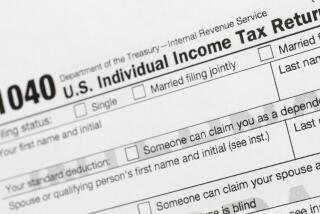For Some, Capital Gains Mean Slower Returns
- Share via
WASHINGTON — With the tax deadline looming, tax preparers who are dealing with more and more procrastinators cite capital gains changes as the culprit.
“I have never seen people being this late,” said Carol Thompson, an enrolled agent in Monterey, Calif. “I think part of it is there is a new tax law, and everyone has been hearing about Schedule D and what a monster it is.”
For the record:
12:00 a.m. April 13, 1998 For the Record
Los Angeles Times Monday April 13, 1998 Home Edition Business Part D Page 2 Financial Desk 1 inches; 27 words Type of Material: Correction
Web address--The Internal Revenue Service Web page address listed in the “Last-Minute Tax Tips” box in Saturday’s edition was incorrect. The IRS Web page is at https://www.irs.ustreas.gov
For the Record
Los Angeles Times Thursday April 16, 1998 Home Edition Business Part D Page 3 Financial Desk 2 inches; 55 words Type of Material: Correction
Income tax--A chart Saturday incorrectly stated the penalty for late tax filings. People who owe taxes and file late are subject to late-filing penalties of 5% of the balance due per month. Those who pay late are charged interest at 8% per annum, compounded daily. In addition, those who have failed to pay at least 90% of the tax owed could be subject to late-payment penalties of 0.5% per month.
The Internal Revenue Service said that as of April 3, 67.4 million taxpayers had filed their federal returns, slightly more than half the 124 million individual income tax returns expected this year. The number of returns filed was about 0.8% ahead of last year’s pace, the IRS said.
“The overall impression is that the filing season is running very smoothly,” said Joseph F. Lane of the National Assn. of Enrolled Agents, tax preparers licensed to practice before the IRS. Lane, who addressed a House Ways and Means subcommittee last week, credited the IRS with improved responsiveness to taxpayer complaints.
The 1997 tax bill reduced the maximum capital gains rate from 28% to 20%. The complex transition rules created by Congress caused the Schedule D capital gains work sheet to double in size to 54 lines from the year before.
Todd Ransom, an H&R; Block spokesman, said the company is expecting many taxpayers to pull out their tax paperwork for the first time after Easter dinner Sunday. “They’ll look at the Schedule D and say, ‘Oh my God, what is it?’ ” Ransom said.
IRS spokesman Don Roberts said more than 1 million tax returns have been incorrectly filed without a Schedule D, even though the taxpayers reported capital gains on line 13 of their Form 1040s. The IRS will send the incomplete returns back to filers, asking them to add a Schedule D, which can further delay refunds.
Roberts said many of these cases appear to involve mutual fund investors who may not realize they have to file paperwork to reflect capital gains distributions.
Another problem concerns errors by mutual funds and brokerage firms on 1099 forms, which provides the amount of dividends, interest and capital gains to be included in the income tax return. Wall Street firms have complained that the various phase-in dates to obtain lower capital gains taxes have made it difficult to calculate data for Form 1099 by the Jan. 31 deadline.
The Securities Industry Assn. said the error rate on 1099 forms tripled to 17% for the 1997 tax year.
Charles Bish, an accountant with the Alexandria, Va., firm Bish & Haffey, said this week he had to amend returns for some clients who received corrected 1099 forms after the Jan. 31 deadline. “It’s very frustrating,” he said, considering that his clients generally have been filing earlier.
Despite earlier reported problems with bar codes on some IRS tax forms, the “IRS appears to be headed toward another generally successful filing season,” the General Accounting Office said last week.
(BEGIN TEXT OF INFOBOX / INFOGRAPHIC)
Last-Minute Tax Tips
It’s crunch time for taxes but be careful. People who wait until the last minute to prepare their returns are the most error-prone of all taxpayers, according to the Internal Revenue Service. A few tips to keep you out of trouble:
* Sign and date your return. Technically, if it’s not signed, it’s not filed. Your return will be sent back, subjecting you to late-filing fees.
* Use the prepared address label. It is coded and tends to speed up the processing of your return.
* Check the postage. Without proper postage, your return may never make it to the IRS. The late filing fee is up to 5% of the tax owed every month the return is late.
* Get forms. On the Internet, download what you need from the IRS Web page at https://www.ira.ustreas.gov. Otherwise, check the local post office or public library. And some tax guides, such as the one published by Ernst & Young, include virtually any form an average taxpayer might use.
* File for an extension. If you can’t make the deadline, file Form 4868, which gives you another four months to procrastinate. If you can’t pay your estimated tax when you send in the extension request, don’t. Interest on the amount you owe will accrue at a 8% annual rate. Butthere no longer is a “late-filing” penalty.
More to Read
Inside the business of entertainment
The Wide Shot brings you news, analysis and insights on everything from streaming wars to production — and what it all means for the future.
You may occasionally receive promotional content from the Los Angeles Times.










